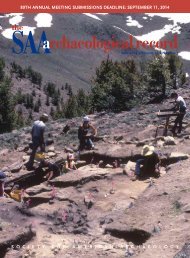SAA
Nov2016_web
Nov2016_web
Create successful ePaper yourself
Turn your PDF publications into a flip-book with our unique Google optimized e-Paper software.
VIDEO GAMES AND ARCHAEOLOGY<br />
hold formation among the Anasazi, say), game rules do<br />
encode ideas about (inter alia) power, ideology, action, colonialism,<br />
and empire. The game theorist Ian Bogost calls<br />
these “procedural rhetorics,” the arguments made by code<br />
(2007); the historian William Urrichio explicitly called code<br />
historiography (2005). Games about the past will be played,<br />
experienced, and internalized by orders of magnitude by<br />
more people than who ever read our formal archaeologies.<br />
And the experience will resonate far more deeply than any<br />
visit to a site or museum. We ignore games as a venue for<br />
our scholarship at our peril.<br />
The Payoff<br />
I have been arguing by omission that the content, the window<br />
dressing (the pretty graphics, the hyperrealistic depictions<br />
of textures and atmospheres, the 3D sound, the voice<br />
acting) does not matter nearly as much as close experience<br />
and engagement with the code and its emergent outcomes.<br />
That engagement allows a connection here with the kind of<br />
archaeology argued for by scholars such as Stuart Eve (2014)<br />
that seeks to use the mechanics of games and allied technologies<br />
such as mixed or augmented realities to focus on<br />
understanding the systems of relationships among the full<br />
sensory experience of the past. Eve calls this an “embodied<br />
GIS” that does not focus on the archaeologist’s subjective<br />
experience of place, but rather explores how sound, views,<br />
and lighting (and indeed, smell and touch) combine or are<br />
constrained by the archaeology of a place, experienced in that<br />
place. This suggests a way forward for the use of games as<br />
both a tool for research on the past and a way to communicate<br />
that research to our various publics.<br />
Finally, we can turn our critical apparatus back to front and<br />
consider games as a venue within which we may do archaeology.<br />
Search online for “archaeogaming.” The most succinct<br />
definition of what this could be comes from Meghan Dennis<br />
(Dennis 2016): “Archaeogaming is the utilization and treatment<br />
of immaterial space to study created culture, specifically<br />
through video games.”<br />
Archaeogaming requires treating a game world, a world<br />
bounded and defined by the limitations of its hardware, software,<br />
and coding choices, as both a closed universe and as an<br />
extension of the external culture that created it. Everything<br />
that goes into the immaterial space comes from its external<br />
cultural source in one way or another. Because of this, we see<br />
the same problems in studying culture in games as in studying<br />
culture in the material world.<br />
Archaeogaming is a subdiscipline that requires the same<br />
standards of practice as the physical collection of excavated<br />
data, only with a different toolset. It also provides the opportunity<br />
to use game worlds to reflect on practice, theory, and<br />
the perceptions of our discipline.<br />
Video games are an extraordinarily rich tool, area of<br />
research, and effective mode of communication whose possibilities<br />
we haven’t even begun to explore. Yet, they are not<br />
so foreign to the archaeologist’s “formal” computational<br />
experience, with ties to GIS, Agent-Based Models, and reconstructions.<br />
Play on!<br />
Acknowledgments<br />
Thank you to Colleen Morgan for organizing this special<br />
issue; to Meghan Dennis, Andrew Reinhardt, and Tara Copplestone<br />
for #archaeogaming; and to Anthony Masinton and<br />
@_sorcha (https://twitter.com/_sorcha) for commenting on<br />
the public draft of this piece.<br />
References Cited<br />
Bogost, Ian<br />
2007 Persuasive Games: The Expressive Power of Video Games.<br />
MIT Press, Cambridge.<br />
Dennis, Meghan<br />
2016 Archaeogaming. Electronic document, http://gingery<br />
gamer.com/index.php/archaeogaming/, accessed October 13,<br />
2016.<br />
Eve, Stuart<br />
2014 Dead Men’s Eyes: Embodied GIS, Mixed Reality and Landscape<br />
Archaeology. BAR British Series 600. Archaeopress,<br />
Oxford.<br />
Kapell, Matthew Wilhelm, and Andrew B. R. Elliott (editors)<br />
2013 Playing with the Past: Digital Games and the Simulation of<br />
History. Bloomsbury, New York.<br />
Kee, Kevin, and Shawn Graham.<br />
2014 Teaching in the Age of Pervasive Computing: The Case for<br />
Games in the High School and Undergraduate Classroom. In<br />
Pastplay: Teaching and Learning History with Technology, edited by<br />
Kevin Kee, pp. 270–291. University of Michigan Press, Ann Arbor.<br />
Masinton, Anthony<br />
2015 Comment on Shawn Graham, “The Video Game and the<br />
Archaeologist—Draft.” Electronic document, https://electric<br />
archaeology.ca/2015/10/15/the-video-game-and-the-archaeologist-draft/#comment-31370,<br />
accessed October 13, 2016.<br />
Urrichio, William<br />
2005 Cyberhistory: Historical Computer Games and Post-Structuralist<br />
Historiography. In Handbook of Computer Games Studies,<br />
edited by Jeffrey Goldstein and Joost Raessens, pp. 327–338.<br />
MIT Press, Cambridge.<br />
18 The <strong>SAA</strong> Archaeological Record • November 2016




